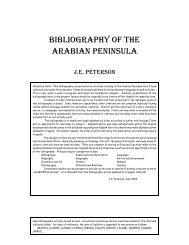THE ARABIAN PENINSULA IN MODERN TIMES: A - JEPeterson.net
THE ARABIAN PENINSULA IN MODERN TIMES: A - JEPeterson.net
THE ARABIAN PENINSULA IN MODERN TIMES: A - JEPeterson.net
Create successful ePaper yourself
Turn your PDF publications into a flip-book with our unique Google optimized e-Paper software.
By the mid‐20 th century, Britain had established a crown colony in Aden and protectorates<br />
over its hinterland, gathered the small Gulf states into de jure or de facto protected status, and<br />
effectively checked Saudi expansion. This required an administrative apparatus that was<br />
exceedingly modest given the vast territory under British control. Earlier works have<br />
concentrated on arrangements in Aden – although Simon Smith has made a more recent<br />
contribution – but Omer al‐Omery and James Onley have written on the residency system in<br />
the Gulf and former ambassadors Richard Muir and Terence Clark have traced the history of<br />
British missions in Kuwait and Oman respectively. Onley also treats the role of the Gulf in the<br />
British Empire, focusing on the reach of British India, while Robert Blyth discusses the struggle<br />
between British India and London for control in the Gulf. John Willis looks at the role of British<br />
India in Yemen while Christian Lekon narrows the subject to the British role in the<br />
Hadramawt. 65<br />
The somewhat wider subject of British relations with regional states and British activities<br />
has attracted a plethora of authors who have examined most aspects of the British presence.<br />
Shafi Aldamer looks at Anglo‐Saudi relations around the period of World War II while relations<br />
with Kuwait in the pre‐1961 period 1961 have been studied by Simon Smith, Andrew<br />
Loewenstein, and Miriam Joyce. Smith and Joyce also contribute studies of relations with<br />
Kuwait, Bahrain, Qatar, and the Trucial States, and an article on British relations with Yemen.<br />
Christopher Davidson also looks at Britain and the Trucial States (as does Miriam Joyce) while<br />
Hussain al‐Mousawi, Lawrence Timpe, and Miriam Joyce Haron examine aspects of the several<br />
centuries of the British‐Omani relationship. Timothy Paris studies the British role in al‐Hijaz,<br />
where the Hashimis were eventually defeated by the Al Sa‘ud and forced to accept the British<br />
offer of thrones in Syria, Iraq, and Transjordan. 66 The gradual British drawdown from its East of<br />
the region: “Subjectivity and Imperial Masculinity: A British Soldier in Dhofar (1968-1970),” Journal of Middle<br />
East Women’s Studies, Vol. 4, No. 2 (Spring 2008), pp. 60-80.<br />
65. Omer Saleh al-Omery, “The Resident in the Gulf: British Power in Transition, 1858-1872” (Ph.D. thesis,<br />
University of Essex, 1989); Simon C. Smith, “Rulers and Residents: British Relations with the Aden Protectorate,<br />
1937-1959,” Middle Eastern Studies, Vol. 31, No. 3 (1995), pp. 509-523; Christian Lekon, “The British and<br />
Hadhramaut (Yemen), 1863-1967: A Contribution to Robinson’s Multicausal Theory of Imperialism” (Ph.D. thesis,<br />
London School of Economics, 2000); Robert J. Blyth, “Britain Versus India in the Persian Gulf: The Struggle for<br />
Political Control, c.1928-48,” Journal of Imperial and Commonwealth Affairs, Vol. 28, No. 1 (2000), pp. 901-11;<br />
James Onley, The Arabian Frontier of the British Raj (London: Oxford University Press, 2007; adapted from his<br />
“The Infrastructure of Informal Empire: A Study of Britain’s Native Agency in Bahrain, c.1816-1900” (DPhil<br />
thesis, St. Antony’s College, University of Oxford, 2001); ibid., “The Politics of Protection in the Gulf: The Arab<br />
Rulers and the British Resident in the Ni<strong>net</strong>eenth Century.” New Arabian Studies, Vol. 6 (2004), pp. 30-92; ibid.,<br />
“Britain’s Native Agents in Arabia and Persia in the Ni<strong>net</strong>eenth Century,” Comparative Studies of South Asia,<br />
Africa, and the Middle East, Vol. 24, No. 1 (2004), pp. 131-139; Richard Muir, “Kuwait,” in Hugh Arbuthnott,<br />
Terence Clark, and Richard Muir, British Missions Around the Gulf, 1575-2005: Iran, Iraq, Kuwait, Oman<br />
(Folkestone, Kent, UK: Global Oriental, 2008), pp. 169-226; Terence Clark, “Oman,” in British Missions Around<br />
the Gulf, pp. 229-253; John M. Willis, “Making Yemen Indian: Rewriting the Boundaries of Imperial Arabia,”<br />
International Journal of Middle East Studies, Vol. 41, No. 1 (February 2009), pp. 23-38.<br />
66. Shafi Aldamer, Saudi Arabia and Britain: Changing Relations, 1939-1953 (Reading, UK: Ithaca Press, 2003);<br />
Hussain Ben Al-Seyed Yousuf Hashim al-Mousawi, “A History of Omani-British Relations, with Special Reference<br />
to the Period 1888-1920” (Ph.D. thesis, University of Glasgow, 1990); G. Lawrence Timpe, “British Foreign Policy<br />
Toward the Sultanate of Muscat and Oman, 1954-1959” (Ph.D. thesis, University of Exeter, July 1991); Miriam<br />
Joyce, Kuwait, 1945-1996: An Anglo-American Perspective (London: Frank Cass, 1998); ibid., Ruling Shaikhs and<br />
Her Majesty’s Government, 1960-1969 (London: Frank Cass, 2003); ibid. (Miriam Joyce Haron), “Britain and the<br />
Sultan of Muscat and Oman and Dependencies, 1958-59,” Diplomacy and Statecraft, Vol. 4, No. 1 (March 1993),<br />
20







